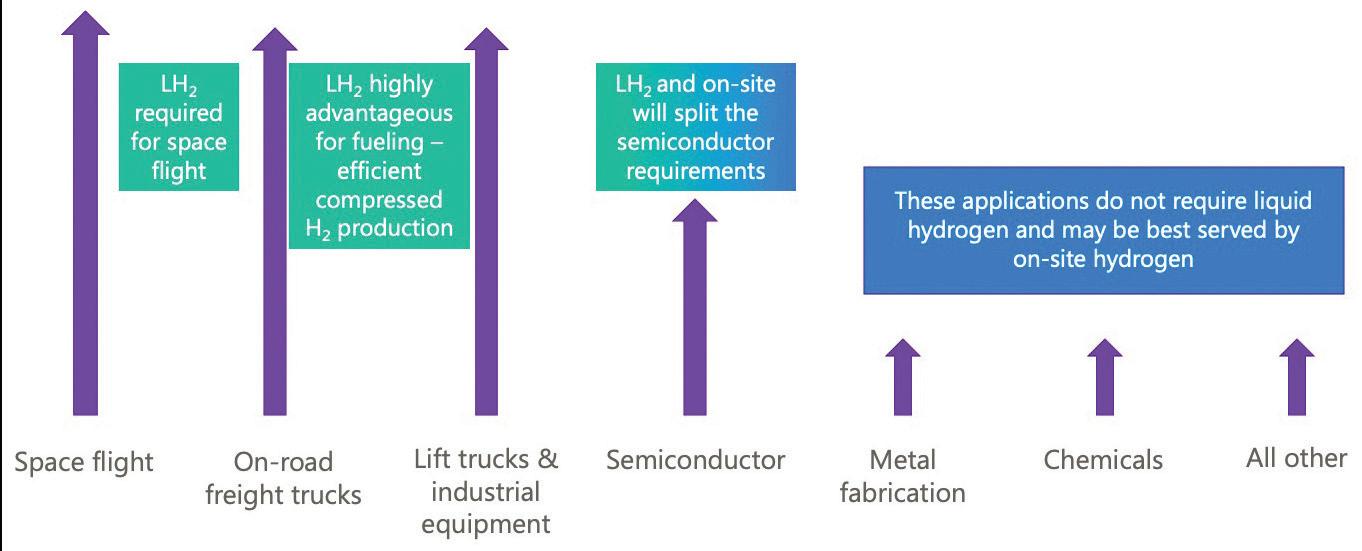
11 minute read
Hydrogen for all
There is currently a shortfall of hydrogen available for traditional industrial uses. David Wolff, Nel Hydrogen, USA, explains why, and explores options for ensuring security of supply.
Hydrogen is a multi-skilled industrial chemical. It is valued as a powerful reducing gas and for its high thermal conductivity, and is widely used for industrial processes such as metals processing and fabrication, as well as chemical processing.
Hydrogen’s reducing and thermal properties are also highly important in semiconductor manufacturing.
In addition to its primary reducing gas and thermal properties, hydrogen has many other unique attributes that are not easily substituted for other products, such as a power plant cooling gas; a lift gas for dirigibles and balloons; a powerful fuel for thermal spray, leak checking, gas chromatography; and more.
There are also new and significant hydrogen requirements that are emerging in the environmental realm, including hydrogen to replace carbon monoxide (CO) in primary steel production and hydrogen to replace natural gas for furnace heating. Additionally, new hydrogen demand is growing from a small base in the mobility market as a fuel for carbon-free transportation for heavy and light-duty vehicles, and in stationary power applications. While demand is up for hydrogen, its availability is showing signs of trending down. This article will explore the reasons for hydrogen’s shortfalls, as well as options for those users that need hydrogen for their processes and products.
Significant trends are narrowing the availability of hydrogen
Hydrogen is generated in certain industrial processes, particularly in chlorine and caustic manufacturing, and petroleum manufacturing. These processes generate excess byproduct hydrogen which is then collected, purified, and made available for distribution to others who need hydrogen for the variety of applications previously mentioned. Its distribution is mostly provided by truck, along with pipeline supply. If hydrogen demand exists, but no byproduct hydrogen is available, it is created by some means of near or onsite generation.
There are three megatrends happening that will strain delivered hydrogen availability. The first is the emergence

of hydrogen as a vehicle fuel for over-the-road freight trucks. From 2010 to 2020, the market for hydrogen in the lift/forklift truck market alone has grown from non-existent to being the top user of liquid hydrogen worldwide, just for lift trucks (fork trucks) used inside factories. The impact on availability when over-the-road freight trucks begin to use hydrogen as fuel, too, will be huge.
The second is the return and expansion of semiconductor manufacturing in the US that is currently happening at speed. The US government enacted the CHIPS for America Act in 2021, and further investment in various semiconductor-related bills are now undergoing the legislative process. In addition to the hydrogen used for annealing in semiconductor fabrication, the emergence of extreme ultraviolet lithography (EUV), which will enable the production of more advanced chips, is expected to double the hydrogen requirement in fabrication shops that adopt the technique.
The third is the resurgence of manned space flights lifting off from the US, which are dramatically impacting the demand for liquid hydrogen. It is important to note that NASA created the needs that spawned liquid hydrogen production in the US in the 1950s, and many of the plants that are now providing liquid hydrogen have been around for 60 or more years. Space Shuttle flights ceased in the US 10 years ago, and the hydrogen that served those flights has gradually been dedicated to industrial customers. Starting in 2022, NASA is going to begin space flights using the Space Launch System (SLS). Each of the SLS’ flights is going to require 50 trailer loads of liquid hydrogen. As such, each flight will require hydrogen equal to one day of production of the entire liquid hydrogen capacity of the US. Additionally, a handful of companies are creating a space tourism market, and some of them use liquid hydrogen fuel.
Liquid hydrogen

Figure 1. Hydrogen is a critical industrial raw material. Many of the products used in everyday life could not exist without it.
Figure 2. As demand for hydrogen continues to grow, and the supply of delivered hydrogen continues to shrink, applications that do not require liquid hydrogen may be best served by onsite hydrogen generation.
Most hydrogen that is delivered to customers today is transported in liquid form for efficiency of transportation. The hydrogen may be delivered as a liquid or may be vaporised and compressed near the use site for delivery as a compressed gas. A lot of fuel cell vehicle fuelling stations begin operation using delivered liquid hydrogen because it is relatively less expensive to produce high-pressure gaseous hydrogen

Table 1. Hydrogen supply options: merchant vs generation
Hydrogen source Volume range Advantages
Liquid hydrogen delivery Medium, from 300 000 to 3 million standard ft³/ month Inherent purity, low capital investment
Compressed hydrogen delivery Low, < 500 000 standard ft³/month Low capital investment, excellent for infrequent use
Onsite generation Low to high Stable pricing, designed for specific use
Drawbacks
Contract implications, price volatility, supply reliability
Anticipated trend
Shortages, reliability issues, price increases
Contract, relatively high gas price, purity Shortages, reliability issues, price increases
Capital investment, back-up Market share increase
Pipeline third party supply Typically high, 3+ million standard ft³/month Predictable pricing Dependency, reliability, back-up May be attractive when possible
which is needed for the vehicle fuel tanks from liquid hydrogen. As those fuelling sites grow, they will inevitably shift to generated hydrogen and gas compression.
All space flight applications require liquid hydrogen for the energy density, and liquid hydrogen is highly valued in semiconductor applications for its simple implementation and inherent purity. Over time, it is projected that approximately half of the semiconductor plants will wind up with liquid and the others will either start or shift over to generated hydrogen onsite, primarily driven by hydrogen demand and availability.
Unfortunately for users, the supply of low-cost, raw byproduct hydrogen is dropping. This is not because of temporary conditions, but rather because of fundamental changes in production of chemicals all over the world. Many chlorine and caustic plants are shutting down in the US and Europe. Furthermore, refinery production is lessening, partly because automobiles now have improved mileage, and because electric vehicles (EVs) and hybrid vehicles have reduced gasoline consumption. Byproduct hydrogen for industrial use from chemical plants and refineries is less than it once was, driving down the supply of raw hydrogen available for liquefaction, just when the demand for it is going up.
More strains on hydrogen supply, demand and costs
Additional liquid hydrogen supply challenges are evident in other costs. For example, the cost of liquid hydrogen distribution trailers have almost doubled over the last few years. They now cost almost US$1.5 million. Meanwhile, lead times for those trailers are out to about 18 months. Liquid hydrogen tanks for siting at customer locations are similarly escalating in price and are delayed in availability. Complicating matters, a standard practice in the liquid hydrogen distribution industry has been to have two tractor drivers so that a trailer can move constantly and not have to stop when a lone driver would be required to rest. It has been big news in the US that there are simply not enough truck drivers to move goods.
Another point is that liquid hydrogen is a highly-specialised commodity requiring safe distribution. The industrial gas industry must be extremely careful in the drivers that it chooses to employ, and it needs to pay at the top end of the payscale in order to retain these drivers.
Frequently, liquid hydrogen transportation involves long distances from the production site to the customer location. The transportation of liquid hydrogen is what is called ‘dead head’ transportation, which means that the hydrogen trailers go out full but return empty because there is nothing else that can be put in a liquid hydrogen trailer. This drives up the cost and reduces the effective use of these expensive liquid hydrogen trailers. It costs between US$4 – 5/mile for liquid hydrogen transportation today, and those costs are rising with the cost of drivers, trailers and fuel. It is also a highly-hazardous cargo which may be unattractive to haulers and drivers. Possibly aggravating the situation further, industrial hydrogen suppliers have suggested that they might convert their tractor fleets over to hydrogen fuel. This is exciting because it demonstrates the technology, but it also means that some of the precious liquid hydrogen is going to fuel the delivery vehicle, meaning that the industrial uses may come up short.


Figure 3. When hooked up to a renewable energy source, both alkaline (top) and PEM electrolysers (bottom) can provide users with a continuous supply of green hydrogen, at a stable cost.
Considering alternatives
Because of the strains on the availability of delivered – or merchant – hydrogen, many of the industrial hydrogen applications such as metal fabrication, chemicals and more should strongly consider whether they might be best served by moving away from liquid hydrogen to other hydrogen approaches that can give them assurance of cost-effective supply. The forces that affect liquid hydrogen costs, and therefore pricing, are the cost of the raw hydrogen, the size of the liquid hydrogen plant, the cost of the electric power at the plant, and the distance from the plant to the customer.
There are several quandaries about tank size at the customer location, too. Generally, industrial gas providers want larger tanks
because they are more efficient for distribution, yet the users of hydrogen prefer smaller tanks because the tank rental is cheaper, and they occupy less space.
How did this happen?
Why has there been so little advance investment in new liquefaction capacity? How did we get to this position?
As described, there are fewer good sources of raw gas. The availability of cheap raw hydrogen is falling for all the reasons presented in this article. Additionally, distribution is by truck. There is no pipeline to the customer to subsidise the investment in a liquid hydrogen plant – it is a great risk on the part of the industrial gas company to build a plant and assume that they will load it with customers. Building the liquefaction plant is only the first stage. Once the plant is built, they must have US$50 million worth of liquid hydrogen trailers to distribute that hydrogen.
Traditionally, liquid hydrogen contractual relationships have been built around a mutual requirements contract. Market disruptions for liquid hydrogen supply have created an opportunity for new types of contractual relationships, such as hybrid liquid hydrogen contracts that will enable hydrogen users to supply a portion of their hydrogen needs by generation, and the remainder to augment their generation supply with delivered liquid or gaseous hydrogen. Users should aim for a consistent supply between generated and delivered hydrogen to pay the same or less money overall as before. Naturally, the unit price of the delivered portion may have to be higher as a less regular buyer.
There are alternatives to delivered hydrogen. Some current users of hydrogen gas blends may be making their own blends out of dissociated ammonia, or they may be cracking natural gas to produce endothermic or exothermic gas. These generation techniques produce the gas blends that are primarily used for metalworking. However, these alternatives have issues of their own in terms of hazardous material storage, gas purity, or – in the case of endothermic and exothermic – carbon dioxide (CO2) emissions. Going forward, large-scale liquid hydrogen users could think about commissioning an onsite gaseous hydrogen plant, or they might receive a pipeline supply from a third party that would build such a plant next door. All users should consider onsite-generated gaseous hydrogen based either on water electrolysis or hydrocarbon reforming technology – steam methane reforming (SMR) – or other type of reformer. For a greener process, only electrolysis technology offers zero-carbon hydrogen.
Back to the future
Barbara Heydorn, a noted hydrogen market expert, was a co-author on the 1988 Chemical Economics Handbook Product Review, ‘Hydrogen’, which is one of the landmark studies of the hydrogen market.1 She pointed out that at one time, electrolysers were the predominant means of
Figure 4. Electrolysers now come in a variety of sizes and hydrogen output volumes – from small industrial units to large-scale megawatt plants to match any application. producing hydrogen for industrial processes. Starting in the 1960s, electrolysers became less popular, as delivered liquid hydrogen took over that role. Now, electrolysers are resuming the predominant role of future hydrogen production, as they have become less expensive, more efficient, smaller, and produce hydrogen with optimal purity. The hybrid contract approach described supplies users with continual hydrogen with a diversity of supply approach, at the lowest possible cost. The return on investment (ROI) is often under five years. Considering the current hydrogen supply and trends, fewer than five years can be attractive compared to facing disruptions and sudden price increases that affect the ability to make products that require hydrogen. The cost of hydrogen by generation is a combination of fixed and variable costs. The fixed cost is the cost of the equipment. The variable cost is electricity, water and maintenance. As the equipment becomes larger in scale, the variable cost dominates. Compared to delivered hydrogen, the fixed cost of buying a piece of equipment may be higher, but the variable cost is much lower than the cost of delivered hydrogen today.
Conclusion
It is certainly a time of change in the deliverable hydrogen market. Hydrogen has become one of the leading stars of the green movement and its many public initiatives to combat carbon emissions around the world. That very movement, however, is causing the supply of merchant hydrogen – for its traditional industrial uses – to decrease. There are also significant trends occurring in the mobility, space travel, and semiconductor markets that will continue to require an increasing quantity of hydrogen. Fortunately, the supply strain is presenting itself just as the capability of onsite hydrogen generation is becoming more feasible than ever.
Reference
1. ‘Hydrogen’, Chemical Economics Handbook Product Review, IHS Market, (1988), https://www.hugedomains.com/domain_ profile.cfm?d=ihsmarket.com











